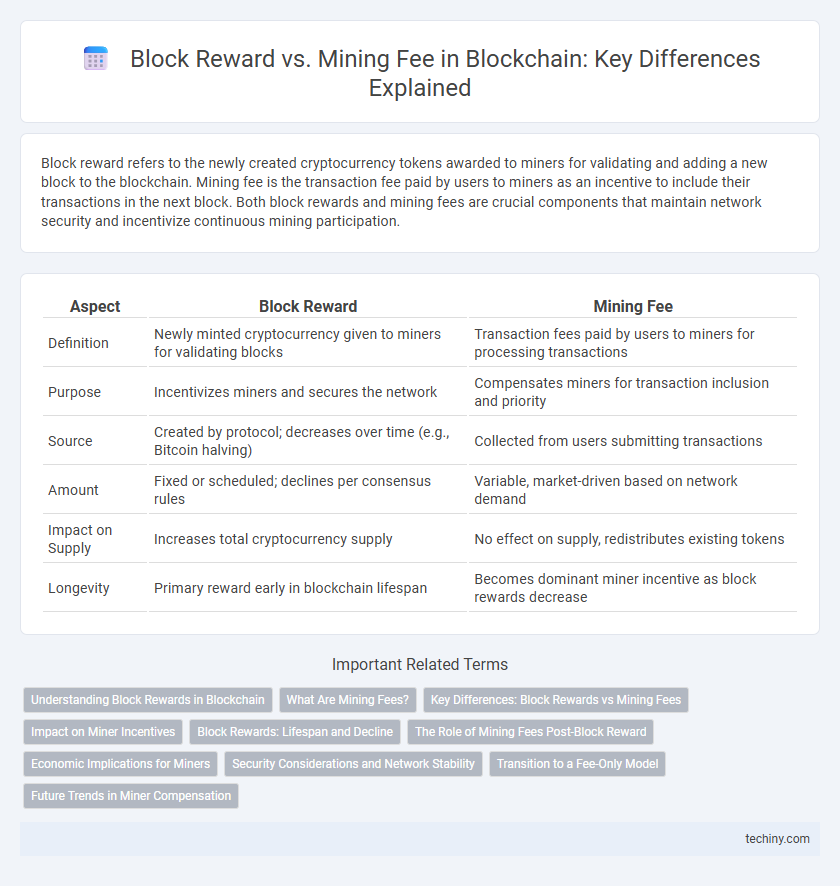Block reward refers to the newly created cryptocurrency tokens awarded to miners for validating and adding a new block to the blockchain. Mining fee is the transaction fee paid by users to miners as an incentive to include their transactions in the next block. Both block rewards and mining fees are crucial components that maintain network security and incentivize continuous mining participation.
Table of Comparison
| Aspect | Block Reward | Mining Fee |
|---|---|---|
| Definition | Newly minted cryptocurrency given to miners for validating blocks | Transaction fees paid by users to miners for processing transactions |
| Purpose | Incentivizes miners and secures the network | Compensates miners for transaction inclusion and priority |
| Source | Created by protocol; decreases over time (e.g., Bitcoin halving) | Collected from users submitting transactions |
| Amount | Fixed or scheduled; declines per consensus rules | Variable, market-driven based on network demand |
| Impact on Supply | Increases total cryptocurrency supply | No effect on supply, redistributes existing tokens |
| Longevity | Primary reward early in blockchain lifespan | Becomes dominant miner incentive as block rewards decrease |
Understanding Block Rewards in Blockchain
Block rewards in blockchain refer to the newly minted cryptocurrency units awarded to miners for successfully validating and adding a new block to the blockchain. These rewards serve as an incentive to maintain network security and encourage continuous mining activity. While block rewards are fixed and decrease over time through processes like Bitcoin's halving, mining fees are transaction-based incentives that fluctuate based on network demand.
What Are Mining Fees?
Mining fees are transaction fees that users pay to miners for including their transactions in a blockchain's next block, incentivizing validators to prioritize their processing. These fees vary based on network congestion, transaction size, and urgency, directly affecting confirmation speed and miner revenue. Unlike block rewards, which are fixed or halving over time, mining fees fluctuate dynamically and represent a crucial component of miners' earnings in decentralized networks like Bitcoin and Ethereum.
Key Differences: Block Rewards vs Mining Fees
Block rewards represent newly created cryptocurrency tokens awarded to miners for successfully adding a new block to the blockchain, serving as an incentive for network security and decentralization. Mining fees are transaction fees paid by users to prioritize their transactions within a block, directly benefiting miners as compensation for processing and validating transactions. The key difference lies in block rewards being a fixed, protocol-defined incentive tied to block creation, while mining fees fluctuate based on network demand and transaction volume.
Impact on Miner Incentives
Block rewards provide miners with newly created cryptocurrency units, offering a consistent incentive to secure the blockchain network, especially in early stages. Mining fees, paid by users for transaction prioritization, become increasingly significant as block rewards diminish over time due to halving events. The balance between block rewards and mining fees directly influences miner participation, network security, and transaction throughput efficiency.
Block Rewards: Lifespan and Decline
Block rewards represent the primary incentive for miners, consisting of newly minted cryptocurrency issued with each validated block, but their issuance follows a predetermined halving schedule that reduces rewards approximately every four years. This gradual decline is programmed to limit total supply and maintain scarcity, resulting in diminishing miner income from block rewards over time. Consequently, the mining ecosystem increasingly depends on transaction fees to sustain miner profitability as block rewards approach zero near a cryptocurrency's maximum supply cap.
The Role of Mining Fees Post-Block Reward
Mining fees have become increasingly vital in maintaining blockchain network security as block rewards diminish through programmed halving events. These fees incentivize miners to validate and add transactions to the blockchain, ensuring continued decentralization and transaction processing efficiency. As block rewards approach zero, mining fees are expected to become the primary revenue source sustaining blockchain miners and preserving network integrity.
Economic Implications for Miners
Block rewards provide miners with new cryptocurrency units, directly increasing their income and incentivizing participation in blockchain validation, while mining fees represent transaction-based earnings that fluctuate with network demand. As block rewards decrease over time due to programmed halvings, mining fees will become increasingly vital for miner profitability and network security. Economic implications include balancing reward structures to maintain miner incentives, ensuring decentralized validation and preventing potential declines in mining activity.
Security Considerations and Network Stability
Block reward provides a consistent economic incentive for miners to maintain network security by validating transactions and adding new blocks, ensuring long-term stability of the blockchain. Mining fees complement block rewards by offering additional compensation, especially as block rewards decrease over time, which helps prevent a decline in miner participation and protects against potential security vulnerabilities. A balanced structure between block rewards and mining fees is crucial to sustaining blockchain network integrity and deterring attacks such as 51% attacks.
Transition to a Fee-Only Model
Block reward represents newly minted cryptocurrency given to miners for validating transactions, while mining fees are payments from users prioritizing their transactions. As block rewards diminish over time due to protocols like Bitcoin's halving, the network is gradually transitioning toward a fee-only model, where miners' incentives rely solely on transaction fees. This shift enhances economic sustainability and security by aligning miner compensation directly with network usage.
Future Trends in Miner Compensation
Future trends in miner compensation are shifting as blockchain networks explore reducing block rewards to mitigate inflation and promote sustainability. Mining fees are expected to play a more significant role in incentivizing miners, driven by increased transaction volume and higher fee markets on networks like Bitcoin and Ethereum. Layer 2 solutions and evolving consensus mechanisms, such as Proof of Stake, will further influence the balance between block rewards and mining fees.
Block Reward vs Mining Fee Infographic

 techiny.com
techiny.com